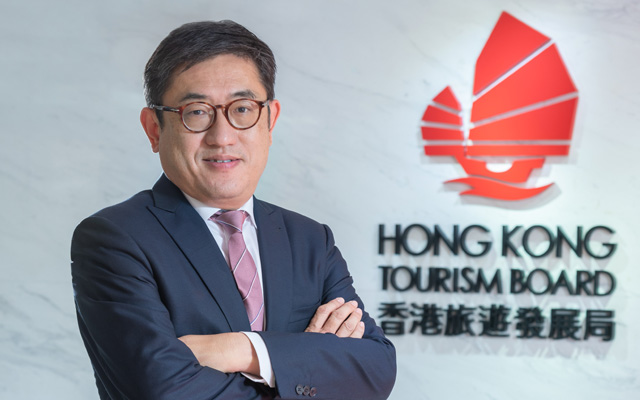Major changes have swept through Hong Kong, and the positive ones are creating vibrant stories that the destination can use to attract travellers, says Dane Cheng, executive director of the Hong Kong Tourism Board (HKTB)
 We have just a little more than a month before 2024 comes along. How do you expect Hong Kong’s travel and tourism community to start off in the new year?
We have just a little more than a month before 2024 comes along. How do you expect Hong Kong’s travel and tourism community to start off in the new year?
I am very optimistic.
People have accumulated a lot of savings from not travelling over the long Covid years, and many are still waiting for the opportunity to make up for lost time. Within Asia, Hong Kong is among the very last destinations to reopen without test requirements and quarantine, so the destination still has some way to go (in terms of recovery).
We have seen how the lack of air capacity, particularly on long-haul routes, has made travel more expensive. So, for many Americans and Europeans, domestic and regional trips are favoured. The time has come for them to head to Asia, as flights to Asia are building up. Last week (US president Joe) Biden and president Xi (Jinping of China) met in the US and spoke about committing to increasing scheduled passenger flights between the two lands. That’s very good news.
However, we have to take currency exchanges into consideration. Hong Kong has became more expensive than four years before, and there is also the added strain of inflation. While Hong Kong is not a cheap place to be, it offers big value which is most important.
Another challenge comes in the form of manpower constraints – this is an issue shared by many other destinations that have reopened. Our hotels are running at about 75 per cent of full operational capacity, so there’s still room for us to open up. Hong Kong International Airport, one of the busiest in the region, also needs time to rebuild staff and bring back more air services. Flights are resuming close to 100 per cent (of pre-pandemic levels) by the end of next year.
I’d say that things are ramping up for us progressively.
What are some changes in the travel and tourism landscape that you’d want Hong Kong’s industry players to take note of?
One obvious change is the rise in people going online for travel stories and ideas, for flights and other transactions. As such, social media is getting very important. As a tourism board, we need to adapt. We no longer just put out ads; we need to have good, genuine and authentic stories. We could hire a KOL (key opinion leader or influencer) or invite a reporter over, but the message has to be authentic. Consumers can tell if the story was genuine or just an official message.
Two, the Chinese travel market is no longer the sort that spends lavishly on travel. It is not that they don’t have money to spend; they do, but they want to spend on the things that they feel is of value. For instance, younger Chinese travellers want experiences that are cool. There is a MacDonnell Road in Hong Kong, somewhere in the expensive Mid-Levels area. This road became an Internet sensation of sorts in China for sharing the name (homophonic) with fast food chain McDonald’s but not having a single McDonald’s restaurant there. Someone posted on social media in China about this, and it went viral. A lot of young Chinese would go to MacDonnell Road with a McDonald’s paper bag just to take a photograph with the road sign.
For the young Chinese, it is not about going to a Michelin three-star restaurant and boasting about it. They are more keen to try out a top local eatery with a two-hour queue line, and then posting a photo of their food on social media.
Three, there is a lot more solo travel or smaller leisure group travel.
HKTB launched a very successful Hello Hong Kong campaign when Hong Kong reopened, and most recently it rolled out Night Vibes Hong Kong. What new initiatives will there be in 2024?
This year is all about reopening, recovery, and reconnecting. Our initiatives are all to make sure that the whole world knows that we are open.
Next year, we’re moving on to conversion. We want people to not just say, oh Hong Kong is nice and interesting, but also make the move to book and come. We will give them reasons to book their trip to Hong Kong; we will go tactical with offerings and packages to drive booking numbers.
We will also be connecting with people who have been to Hong Kong and know about Hong Kong, and have them tell the Hong Kong story.
You spoke about the rise of social media in destination marketing. Where does the travel trade media, like TTG Asia Media, fit in? Is the trade media channel still relevant?
Oh yes, trade media is important because you need businesses to deliver tourism outcomes. There are consumers who want to travel, truly travel, and not just go shopping in the destination. We want to be able to connect such visitors with expert travel and tourism businesses, especially the SMES – most tour operators are SMEs. These SMEs will be able to provide value to travellers.
In the last two or three years during the lockdown, Hong Kong people could not go out and overseas travellers could not come in. So, we encouraged Hong Kong people to be tourists, and that led to some very interesting developments. They explored local neighbourhoods, spent at local shops, and discovered hidden gems. That generated a lot of story ideas that we were able to use in our international destination marketing through the travel trade channel.
The travel and tourism industry continues to use 2019 as a benchmark of business rebound. But with so many changes in the marketplace, such as in terms of travel habits, major source markets, and travel conditions, should different key performance indicators be considered?
In 2018, we had record high number of arrivals, hotels were doing 90-plus per cent (in terms of room occupancy), and flights were all very full. Well, when Covid came, everything slowed down.
I would not want to compare our recovery now with the peak we experienced in 2018. We must remember that while we did so well in 2018, the whole experience wasn’t all that good for our tourists and our residents. Hong Kong was overcrowded that year.
So, I am quite clear about this – I do not wish to pursue 100 per cent of (what we got in) 2018. Instead, I want Hong Kong to recover on the back of high-end travellers who appreciate the value of Hong Kong. To attract these people, we need high quality offerings.
I also want to see Hong Kong being regarded as the perfect gateway to the whole of Asia, to China, and to the Greater Bay Area. I think we have a fantastic opportunity to do this because of the accessibility of this area. The Hong Kong West Kowloon railway station, which connects to the high-speed Guangzhou-Shenzhen-Hong Express Rail Link, runs 180 services every day. It brings travellers from Hong Kong to so many Chinese provinces and cities in quick time. Shenzhen is just 30 minutes away. Guangzhou East is less than an hour from Hong Kong.
The high-speed rail is just one mode of transport – there is also the Hong Kong–Zhuhai–Macau Bridge.
Furthermore, Hong Kong International Airport is transforming into an airport city. There is a lot of construction now, and eventually the whole area will be integrated and easy for people to move around.
This ambition is ideal because people now want to do more on a single trip, and this approach benefits not just Hong Kong alone.
Perhaps another tourism key performance indicator could be travellers’ satisfaction level and strength of desire to revisit.
I know that the media tend to look at the numbers and the economic benefits, but if we want sustainable tourism performance, we should not just milk the cow and get everyone to come into Hong Kong. Measurement of tourism performance should not just solely be tourism spend and duration.
Hong Kong’s ongoing transformation is amazing – the massive SkyCity development and the West Kowloon Culture District for instance. As someone living in Hong Kong and seeing these urban developments over the years, what are you most proud of?
Hong Kong has blossomed. We now have a much better story to tell people who have never been to Hong Kong as well as those who have been to Hong Kong years ago.
The whole art and cultural scene in Hong Kong is thriving. The new Hong Kong Palace Museum, for example, is outstanding because it offers a whole different experience from Beijing’s Palace Museum. The Hong Kong Palace Museum exhibits many antiques and artefacts that are uniquely on loan from The Palace Museum in the Forbidden City.
We are also doing great with our wellness promotion. While we used to promote Hong Kong’s outdoor draws, it was never this strongly. Hong Kong’s great outdoors is a huge advantage – travellers can easily go from the shiny city centre to a laid-back outlying island within 20 or 30 minutes, or mix city outings with a hike or cycling activity.
All these new developments are enriching Hong Kong’s positioning as Asia’s entertainment and business capital.
I’m also so proud of Hong Kong’s culinary strength, which continues to impress locals and visitors. F&B business is very competitive in Hong Kong, which means operators have to be excellent in order to survive. Furthermore, Hong Kong people are very demanding – yes, unforgiving diners (laughs) – so culinary quality here is very high.
South-east Asia as a region has been doing particularly well for Hong Kong this year – collective arrivals are only second to massive China. Are there certain source markets in South-east Asia that HKTB would like to invest in more?
Arrivals from Thailand and the Philippines are doing extremely well, and numbers for October may have exceeded pre-pandemic levels.
We’re excited to see that the government is relaxing entry visa rules for Vietnamese passport holders. Vietnam is a very important source market, as outbound traffic has been doing rather well for several destinations including Japan and South Korea. Vietnam is a market that Hong Kong was not able to capture in the past, so we will be investing more in that.
Hong Kong has always been a very popular destination for the regional market. These days we are seeing multi-generation family groups coming in from South-east Asia, and the richer ones can be seen having breakfast here at The Peninsula Hong Kong. I feel that The Lobby (the hotel’s restaurant popular for its lavish breakfast and afternoon tea) is a barometer for Hong Kong’s tourism performance, and this morning this place is buzzing.




















